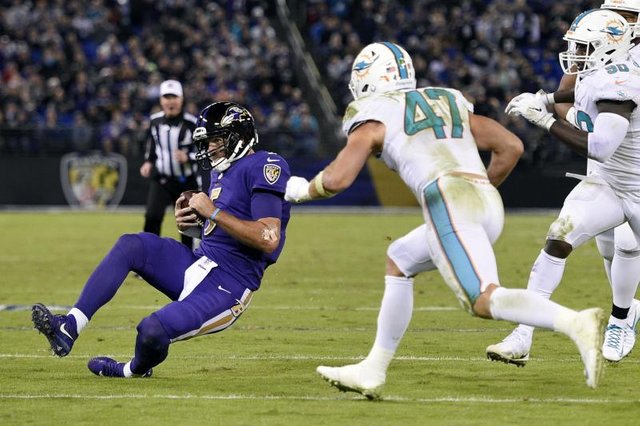NFL Officials Botch Player Safety Again After Brutal Hit on Joe Flacco

The NFL continuously reminds anyone willing to listen that player safety is the league's top priority, yet the actions of its officials represent that it isn't a priority at all.
Twenty-seven days after Chicago Bears linebacker Danny Trevathan received a suspension for a vicious helmet-to-helmet hit to Green Bay Packers wide receiver Davante Adams, the league must explain why Miami Dolphins linebacker Kiko Alonso wasn't ejected for a similar hit Thursday night on Baltimore Ravens quarterback Joe Flacco.
With 3:13 remaining in the second quarter of a 40-0 victory, Flacco rolled to his right on 3rd-and-10. None of his receivers worked their way open, and the 6'6", 245-pound signal-caller lumbered toward a first down. Alonso bore down on Flacco with the intent to stop him from converting a first down.
The quarterback made the decision to start his slide two-to-three yards short of the marker. Alonso didn't let up and still blasted Flacco, per CBS Sports' Will Brinson:
The Ravens organization immediately placed Flacco into the concussion protocol and at halftime ruled him out for the rest of contest.
It was a needless, awful hit, which begs the question: Why wasn't it considered a flagrant foul, thus warranting an automatic ejection?
Alonso received an unnecessary roughness penalty, but he stayed in the contest and finished second on the Dolphins with five tackles.
Two arguments are being made in the linebacker's favor. First, the speed of the game makes it nearly impossible to redirect once a defender is in motion. Second, Flacco slid late.
Neither is true, as the Glenwood Post Independent's Josh Carney illustrated with an in-game screen capture:
Yes, the game is played at breakneck speed. No one denies how fast athletes are at the NFL level. However, defenders are taught to make a decision on whether to hit a quarterback within a one-to-two-step radius. It's often the difference between a sack or a late hit. Split decisions like these are made all the time.
Nearly four yards separated Flacco and Alonso when the quarterback started his slide. Alonso already made up his mind to hit him instead of pulling up short.
Intent existed in Alonso's hit, as former NFL lineman and SiriusXM NFL Radio's Ross Tucker noted:
The linebacker didn't try to tackle the quarterback. He intended to blow Flacco up upon contact. It's why he led with his shoulder and forearm instead of trying to wrap up his target.
Similar arguments were made in Trevathan's favor. The linebacker couldn't pull up in time nor account for Adams' lowering his helmet level. The officials decided not to call a flagrant foul for his hit, either.
Yet the league in its infinite wisdom suspended the Bears defender after the fact.
This sends a mixed message. Either these hits are suspendable acts, and thus need to be called flagrant on the field, or they're not. They can't be both. Again, Tucker serves as the voice of reason:
Issues exist due to the subjectivity found within the rule. As stated when assessing Trevathan's hit, the league's competition committee approved automatic ejections for "egregious" hits to the head in March, per NFL Network's Ian Rapoport.
How does the NFL define an "egregious" hit to the head and why isn't it a reviewable play? Of course, replay doesn't take into account speed of the game and makes any hit look worse when viewed frame by frame. But it's still better to get all the camera angles than just one look in real time.
The NFL couldn't even respond without a day to prepare a statement. Senior vice president of officiating Al Riveron "will not have a comment tonight," per CBS sideline reporter Tracy Wolfson during the telecast.
The "I know it when I see it" approach isn't working, though, especially when a quarterback is involved.
Sure, everyone gets a dig in at Flacco's expense every now and then. But quarterbacks are still the league's most precious commodities and can't have their heads taken off when they slide.
Bleacher Report's Mike Freeman posed an interesting question regarding the situation:
The question is rhetorical because everyone knows the answer.
Certain star quarterbacks are protected far more than others. There's a reason the "Brady rule" exists. For those who have never heard of the Brady rule, it prevents defenders from going low on a quarterback's legs. The league enacted said rule after Tom Brady suffered a season-ending knee injury during the New England Patriots' 2008 opener against the Kansas City Chiefs.
The league's response will be as predictable as it is pathetic.
Alonso will be suspended. The NFL Players Association will argue the hit wasn't called flagrant during the contest, and the suspension will be reduced, just as Trevathan's suspension was shortened from two games to one. Meanwhile, the league won't clarify its stance on flagrant fouls and continue to discuss how the players' safety remains of utmost importance.
Nothing of substance actually occurs.
Getting serious and sending a message to players willing to take shots against a defenseless quarterback remains in the league's best interest. The NFL should act accordingly by better defining its flagrant foul parameters and suspending Alonso for more than one contest.
Brent Sobleski covers the NFL for Bleacher Report. Follow him on Twitter: @brentsobleski.